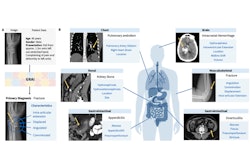Software as a medical device (SaMD)-based AI is "poised to transform clinical care by leveraging AI to drive innovation, improve radiology workflow, and improve patient outcomes," according to a commentary published August 10 in the Journal of the American College of Radiology.
But there are issues that need to be addressed, particularly reimbursement for use of SaMD, wrote a team led by Joshua Liao, MD, of the University of Texas Southwestern Medical Center in Dallas.
"The adoption of SaMD-based AI tools remains limited by evolving but nascent reimbursement policies," Liao and colleagues Ezequiel Silva, MD; Melissa Chen, MD; Ryan Lee, MD; and Christoph Lee, MD, noted. Silva is at the University of Texas Health in San Antonio; Chen is at MD Anderson Cancer Center in Houston; Ryan Lee is at the University of Nebraska Medical Center in Omaha; and Christoph Lee is at the University of Wisconsin School of Medicine and Public Health in Madison.
In the commentary, the authors discussed two key concerns when it comes to incorporating SaMD into radiology practice:
- What principles should guide radiology practices, health systems, policymakers, and healthcare leaders in developing reimbursement and care delivery frameworks that promote SaMD integration into medical imaging while ensuring that such technologies in turn promote high-value and cost-efficient care?
- What safeguards or incentives are needed to ensure that SaMD use leads to improved diagnostic imaging accuracy, efficiency, or patient outcomes?
Silva, Chen, and Ryan Lee in particular spoke to these questions, with Silva explaining, "Reimbursement for SaMD remains inconsistent, failing to keep pace with the rapid growth and potential of AI-enabled devices and potentially hindering clinical adoption." She added that "Addressing this challenge requires more than adapting existing payment systems or creating new ones; it demands consistent terminology to inform payment frameworks while supporting innovation."
For her part, Chen wrote, "Cost-effectiveness and outcome assessment should be considered when determining reimbursement eligibility for SaMD," noting that "policymakers need to account for the fact that FDA-approved AI algorithms have undergone only limited real-world testing, which has not specifically assessed clinical effectiveness or value," and that although "software has historically been considered an indirect practice expense in the MPFS … SaMD can garner direct practice expense based on the pricing models of vendors, which can vary by institution depending on volume and may disproportionately favor larger institutions over smaller practices (e.g., subscription models)."
Finally, Ryan Lee explained, "As AI continues to develop, it is inevitable that its application in radiology continues to expand," writing that "while there may be isolated cases of reimbursement from third-party payors for some applications, global professional reimbursement for SaMD will continue to be an uphill battle."
The takeaway? Radiology must "carefully assess local investment -- and return on that investment -- when implementing SaMD" and "consider factors such as limited direct reimbursement to date among payers; limited testing threshold requirements for [U.S. Food and Drug Administration (FDA)] clearance and the potential for algorithms to perform more poorly in local populations than marketed; and the need to appropriately share SaMD costs with other stakeholders, such as affiliated health systems," the authors concluded.
The complete commentary can be found here.




















